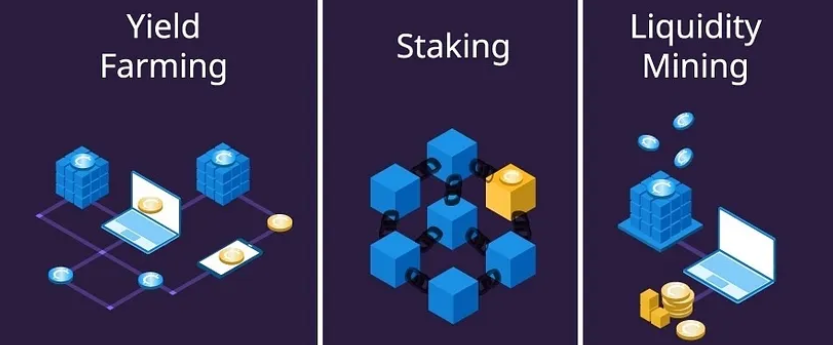In the fast-paced world of cryptocurrency and DeFi, exciting opportunities like yield farming, liquidity mining, and staking have taken center stage. They’re like modern-day financial adventures, letting you earn rewards and passive income. But, like any adventure, there are risks to navigate. In this article, we’ll take a deep dive into these concepts, explaining them in plain language and uncovering the mechanics beneath them. So, whether you’re a crypto enthusiast or just curious, join us as we explore the world of yield farming, liquidity mining, and staking, and learn how to tread carefully in this thrilling financial landscape.
Bybit offer: Deposit $50, and GET 10 USDT (withdrawable)!
Yield Farming: The Basics
Yield farming is a DeFi strategy where users provide liquidity to decentralized platforms in exchange for earning rewards. Liquidity is crucial for the efficient functioning of decentralized exchanges (DEXs), and yield farmers play a pivotal role in supplying assets to these platforms.
Also read: A Comprehensive Guide To Investing In Decentralized Finance (DeFi)
How Yield Farming Works:
1. Liquidity Provision: Users deposit their cryptocurrency assets into liquidity pools on decentralized platforms like Uniswap, PancakeSwap, or SushiSwap.
2. Earning Rewards: In return for providing liquidity, users receive tokens representing their share of the pool. These tokens are often called LP (Liquidity Provider) tokens.
3. Yield Generation: Users can then stake their LP tokens in yield farming protocols to earn additional tokens as rewards. These rewards can include project tokens, governance tokens, or platform fees.
Example:
Suppose you provide liquidity by depositing equal amounts of ETH and DAI into a Uniswap liquidity pool. In return, you receive UNI-V2 LP tokens, which represent your share of the pool. You can then stake these LP tokens in a yield farming protocol to earn more tokens, such as UNI tokens, as rewards.
Liquidity Mining: An Incentive Mechanism
Liquidity mining is a subset of yield farming that focuses on incentivizing users to provide liquidity to specific pools or platforms. This strategy is often used by DeFi projects to bootstrap liquidity and attract users to their ecosystems.
Key Elements of Liquidity Mining:
1. Incentive Tokens: DeFi projects distribute their native tokens as incentives to liquidity providers. These tokens have value and can be traded or held.
2. Yield Maximization: Users can maximize their yield by participating in liquidity mining programs, where they are rewarded with additional tokens for contributing liquidity.
3. Project Growth: Liquidity mining programs aim to stimulate activity and liquidity within a project’s ecosystem, ultimately fostering growth and adoption.
Example:
A decentralized exchange project launches a liquidity mining program, offering users rewards in the form of their native exchange tokens for providing liquidity to specific trading pairs. This incentivizes users to contribute liquidity, resulting in increased trading volume and a more vibrant ecosystem.
Staking: Locking Assets for Rewards
Staking is a DeFi practice where users lock up their cryptocurrency assets in a smart contract, effectively “staking” them as collateral. In return, they receive rewards in the form of additional tokens. Staking is commonly associated with proof-of-stake (PoS) blockchains.
Key Components of Staking:
1. Locking Period: Users commit their assets for a predetermined period, during which they cannot access or move them.
2. Rewards: Stakers earn rewards, often in the form of the blockchain’s native tokens, for validating transactions or participating in network security.
3. Security and Governance: Stakers play a crucial role in securing the network and may have voting rights in protocol governance decisions.
Example:
In a PoS blockchain network, users can stake a certain amount of their tokens in a validator node. In return, they receive additional tokens as rewards for helping to secure the network and validate transactions.
The Risks Associated with DeFi Strategies
While yield farming, liquidity mining, and staking offer lucrative opportunities, they also come with inherent risks that should not be overlooked. Below, we outline some of the key risks associated with these DeFi practices:
1. Impermanent Loss: Liquidity providers in automated market maker (AMM) pools, such as Uniswap, are exposed to impermanent loss. This occurs when the price of the assets in the pool changes, causing the value of their LP tokens to diverge from the initial investment.
2. Smart Contract Risk: DeFi platforms and protocols are built on smart contracts, which are not immune to vulnerabilities or exploits. Users may face the risk of losing their assets if a smart contract is compromised.
3. Market Volatility: Cryptocurrency markets are highly volatile. Price fluctuations can result in the depreciation of assets held in liquidity pools or staking contracts, affecting the overall return on investment.
4. Rug Pulls and Scams: The DeFi space has seen its share of fraudulent projects and “rug pulls,” where developers exit with users’ funds. Investors should conduct due diligence and choose reputable projects.
5. Imposed Penalties: Staking often involves locking up assets for a specific period. Early withdrawal or failure to meet protocol requirements may result in penalties or loss of staked assets.
6. Regulatory Uncertainty: The regulatory landscape for DeFi is still evolving. Users may face legal risks depending on their jurisdiction, and changes in regulations can impact DeFi activities.
7. Liquidity Risks: In yield farming, users may encounter difficulties withdrawing their assets from illiquid pools during times of high demand or congestion on the network.
8. Token Price Risk: The value of the tokens received as rewards in yield farming or liquidity mining can be highly volatile, affecting the overall profitability of these activities.
Risk Mitigation Strategies
To mitigate the risks associated with yield farming, liquidity mining, and staking, users can employ several strategies:
1. Diversification: Spread investments across different projects and platforms to reduce exposure to any single risk.
2. Research: Conduct thorough research on the projects you are considering for participation. Review the team, code, and community to assess credibility.
3. Due Diligence: Be cautious when providing liquidity or staking in new or unaudited projects. Stick to well-established and audited protocols.
4. Risk Assessment: Evaluate the risk-reward ratio of each DeFi strategy. Understand the potential rewards and the likelihood of associated risks.
5. Use of DeFi Insurance: Consider utilizing DeFi insurance platforms that provide coverage in the event of smart contract exploits or hacks.
6. Stay Informed: Keep up-to-date with the latest news and developments in the DeFi space, as changes in protocols or regulations can impact your investments.
Conclusion
Yield farming, liquidity mining, and staking have revolutionized the way users interact with cryptocurrencies and DeFi platforms. While these strategies offer enticing opportunities for generating income, it is vital to approach them with a clear understanding of the risks involved. By diversifying investments, conducting thorough research, and practicing due diligence, users can better navigate the DeFi landscape and make informed decisions to mitigate potential risks. As the DeFi space continues to evolve, staying informed and adapting to changing circumstances will be key to maximizing the benefits while safeguarding against adverse outcomes.
 English
English
 Deutsch
Deutsch
 Español
Español
 Français
Français
 Português
Português
 日本
日本
 한국인
한국인
 Türkçe
Türkçe
 Русский
Русский
 Tiếng Việt
Tiếng Việt














